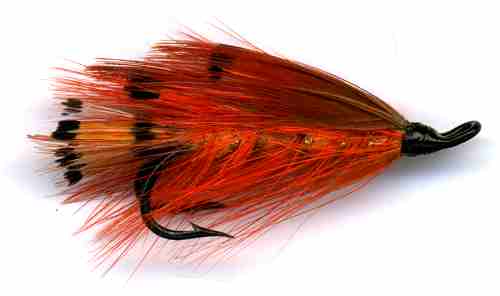The General Practitioner Double Hook Salmon Fly
The General Practitioner imitates the shrimp and prawn that salmon feed on in the sea. It was designed in 1955 to fish the border salmon rivers of Scotland and England by Lt Colonel Esmond Drury (retired). It was also used on the River Test

SALMON DOUBLE HOOK FLY PATTERNS. Hook size 4 6 8 10 - $US each
Anglers on that salmon fishing 'beat' used to use live shrimp on a hook to fish for salmon. The land owners banned this practice so Drury developed this fly to imitate the native Northern Shrimp. He tied the fly on size 2 hooks but found that the smaller hooks caught more fish especially in the more shallow water areas. The original consisted of golden-pheasant body feathers and orange fur. He called this fly G.P. at first because of the golden pheasant feathers that went to make up the large part of this pattern. The General Practitioner has a better record than most, fished on a floating line at low levels in the summer. It has proved very effective on a wide range of waters from America, Canada, Scandinavia, Britain and Iceland. The name changed to General Practitioner because in the British medical profession a local family doctor was called a GP, a general practitioner of medicine as opposed to a specialist like a surgeon. It is a very popular and effective fly in brownish and murky rivers.

Fly Fisherman Lt Colonel Esmond Drury designer of the General Practitioner Salmon Fly pattern with a brace of salmon caught on the River Wye
Many British Salmon fly fishermen who fish near the Scottish border prefer a larger fly fished on a sunken line during the early and late season's colder water conditions. The fly is worked to imitate the natural movement of shrimp. This is achieved by swinging the General Practitioner down through pools, whilst raising and lowering the rod tip in an effort to impart natural movement. Don't expect strikes every time you use this fly. Sometimes the bait will be taken by salmon as soon as it appears in their neighbourhood. Other times it will be the cause of of them exiting the pool very quickly. When this happens a change in size and a softer approach may be the correct tactic. You can also hang the GP fly over the lie of a salmon if you have a long rod. Mending the line when required enables you to fish the pool at a steady pace giving the salmon the chance for a good look at the fly.
When Esmond Drury first tied the original general practitioner fly around 1955, he was aware that he had not fully solve the problem of how to imitate the eyes of a prawn/shrimp. He had observed that the old established fishermen who used natural prawns would replace them as soon as the eyes had gone missing through damage having bee. The trick the n bounced on the riverbed. He therefore concluded that the eyes were an important feature to imitate on any salmon shrimp fly. Lt Colonel Esmond Drury (retired) wanted his prawn fly to imitate the natural prawn as best as he could. This therefore involved, including something to imitate or suggest the prawns black eyes. At first he used to Golden pheasant Tippit severs that had their centres removed. He tied them down on top of each other. Esmond was not happy with the result. The fly worked as it caught salmon, but did not look correct. He wanted a good-looking fly made of traditional and acceptable materials that could be fished anywhere without stretching the fly only rules that applied on certain rivers
We found the solution a few years later whilst sitting in his office. As normal, there were a few fly tying materials scattered over his desk. In particular there was a well marked Golden pheasant Tippit feather. It's black bands were wider and more closely knit then upper feathers, so he cut off the central top half of the feather making a V shape. The black bits on the tip of each prong were now going to be the prawn's eyes. Over the years there have been many variations from the original fly design and they all seem to catch salmon if fished properly.
The original general practitioner salmon fly was tied on a size 2/0 double hook but was later commercially sold on a size 2 treble which was equally as attractive salmon and very much better holder and hooker of fish. Whilst experimenting, Esmond found that smaller versions of the fly were very effective in low-water. This was especially true if you could get in above a known salmon lie and hang the fly over it in the current, whilst moving the General Practitioner fly slowly side to side. The trick is not to be impatient, but to slow down and wait for a take. Wait for the salmon to notice your fly and then get annoyed with it. This will trigger reflex attack instinct.

